8 Steps to Pick the Right Tennis Racket
With the huge selection of tennis rackets available, it is not easy to keep track of the situation. For many tennis players the search for a suitable racket is therefore too time-consuming. Most players eventually reach for the next better racket they can find.
Basically, the tennis racket is the most important accessory of the player on the court. That’s why we’ve developed this racket guide to help you find the right racket in no time.
Since every player has different preferences and skills, there is no general answer to the question of the right racket. Important factors for the selection are your skill level and your playing style. Your fitness also plays an important role.
On this page we give you the 8 criteria that you need to consider when choosing a racket. In addition, you will receive tips and tricks on how to optimize your racket even further.
Contents
1. Head Size
2. Length
3. Beam Width
4. Stiffness
5. Weight
6. Balance
7. Grip Size
8. String Pattern
The Different Parts of a Tennis Racket
The tennis racket can be divided into three sections: The handle, the throat and the head.
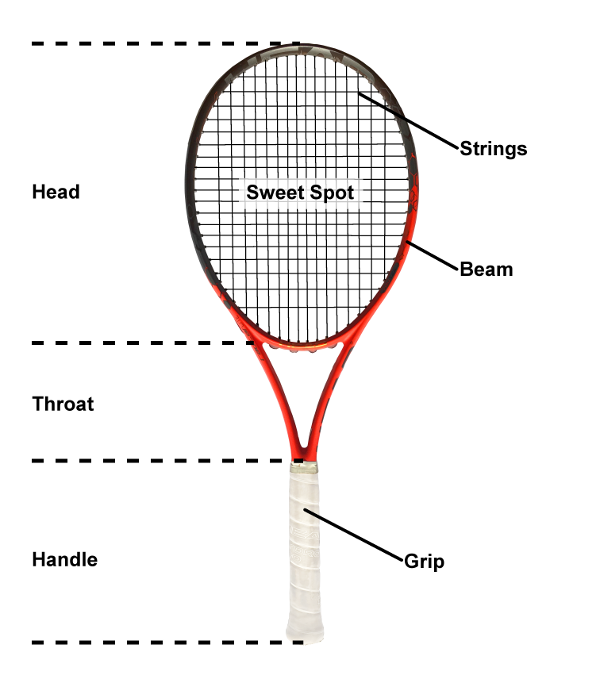
Handle
The grip is the connection between the racket and the hand of the tennis player. Therefore it is important to adapt the grip optimally to the hand. We distinguish between different grip sizes and shapes. The overgrip also has an influence on the grip size.
Throat
At this point the thin grip merges into the wide racket head. This gives the throat its typical V-shape. A horizontal bracing connects both sides of the V to increase the stability of the throat of the racket.
Head
The racket head is the face of the tennis racket. An important component of the racket head is the stringing. The string bed is clamped in the frame and is composed of several main strings (vertical) and cross strings (horizontal). In general you can choose between different racket head sizes, string materials, string patterns and string tensions.
Sweet Spot
The sweet spot is of particular importance for a successful game with the tennis racket. The sweetspot is the area of the string bed where a player hits the tennis ball with the greatest acceleration and accuracy.
The Vibration of the frame is lowest here. This is why this area is also called the ideal contact point. Depending on the head size and the type of strings, the size and position of the sweet spot changes.
1. Head Size
The racket head size indicates the size of the face of a tennis racket. The head size essentially influences the control of a racket and the acceleration of the ball during the stroke.
The larger the racket head, the larger the sweetspot. This is the area where you can hit the ball at maximum acceleration. So you have more power with a big racket head.
In addition, the larger the area, the fewer badly hit balls you have. That’s why a large racket head is especially suitable for beginners. The downside of a large racket head is that you have less control over the ball.
A smaller racket head has a smaller sweetspot, but the advantage is that you can hit the ball with more precision. So if you are an advanced player or professional, choose a racket with a small head size.
You can choose between four different head sizes: Midsize, Midplus, Oversize and Super Oversize. The racket head size is measured in either or inch² or cm². 1 inch² equals 6.45cm².
| Head Size | Size in inch² | Size in cm² |
|---|---|---|
| Midsize | Up to 96 inch² | Up to 625 cm² |
| Midplus | 96 – 105 inch² | 625 – 680 cm² |
| Oversize | 106 – 115 inch² | 681 – 740 cm² |
| Super Oversize | From 115 inch² | From 740 cm² |
2. Length
The racket length is the distance from the grip end to the end of the racket head. You have two options when choosing the racket length:
Most tennis rackets have the standard length of 27 inch (68.6 cm) . However, there are also rackets in excess length up to 29 inch (73.7 cm) . These are called longbody rackets.
A standard length racket is generally easier to maneuver than a longbody racket. This also gives you better control. If these two points are important to you, then a standard length racket is the best choice.
A longer racket will automatically give you a wider reach. The extra length also increases the leverage when hitting the ball. Overall, you can create more power with a longer racket.
3. Beam Width
The beam width is the key figure for the height or thickness of the racket frame. Here you can choose between a thin or a thick frame. The unit of measurement for the frame height is millimetre. Instead of a uniform frame height, some manufacturers specify the individual heights from the three areas of racket head, the middle and the throat, e.g. “21-23-21 mm”.
A thin frame has a height of 17 – 24 mm and is generally more flexible. This characteristic causes the frame to warp more when hitting. You therefore have better control of the shot, but you have to sacrifice some power.

A thick frame can be recognized by a frame height of 25 – 30mm. As a thicker frame is stiffer, you have a relatively smaller loss of energy when hitting the ball. This means that you can generate higher acceleration. In contrast to the thin frame, however, you have slightly less control over the ball.
4. Stiffness
Just like the frame height, the frame stiffness has an influence on power and control. The unit for frame hardness is called RA. It is indicated on a scale from very flexible (0 RA) to very stiff (100 RA). The majority of Rackets are in the range of 50 – 70 RA.
A flexible frame has a frame stiffness of less than 70 RA. If you would like to play a racket with lots of control, then this frame is just right for you.
A flexible frame deforms more on contact with the ball than a stiff Frame. Therefore, the energy loss is greater, which means less acceleration. However, you can compensate for the energy loss with your own power when you are more advanced.
If you are a beginner, we recommend choosing a stiff frame. This is characterized by a frame stiffness of more than 70 RA. In this case, the racquet helps you hit the ball by accelerating the ball better. This means you have to use less force yourself. Especially if you have only recently started playing tennis and your power is not yet so great.
5. Weight
Racket weight is a very important factor in choosing the right tennis racket. Weight affects both maneuverability and comfort as well as the performance of the racket .
Racket weight is divided into four different categories from “very light” to “heavy”. The weight of most tennis rackets is in the middle range (10.0 – 10.5 oz).
In principle, you can swing a light tennis racket easier than a heavier one. The good maneuverability makes it easier for you to react to incoming balls. This is especially useful for volleys at net, as you need an extremely short reaction time.
However, you have to remember that a racquet with less weight will result in less power. In addition, vibrations on contact with the ball are not absorbed as well, which reduces the comfort. Overall, a lightweight racquet is more suitable for beginners to learn basic stroke techniques.
A heavy tennis racket is generally more powerful. With this racquet, you will have a higher power. In addition, the weight improves the stability of the racquet on contact with the ball. This automatically increases the control of the stroke.
Another advantage is that a heavier racquet creates less vibration, giving you a comfortable shot. Many advanced players will therefore choose a medium to heavy racquet.
| Category | Weight in oz |
|---|---|
| Very light | Up to 8.5 g |
| Light | 8.5 – 9.9 oz |
| Medium | 10.0 – 10.5 oz |
| Heavy | From 10.5 oz |
Tip: If your desired racket does not have the right weight, you have the possibility to adjust it. You can make a racket heavier at any time, for example by using lead tape. Making a tennis racket lighter, however, is hardly possible.
6. Balance
The balance point indicates the center of weight of the tennis racket. This is where the racket is evenly balanced. In General, the balance point is measured from the butt cap of the racket. Depending on the weight distribution, you can choose between a head heavy, head light or balanced racquet.
The standard length of a tennis racket is 27 inch. For a balanced racket, the balance point is 13.5 inch. If the balance point is above this value, the racket is top-heavy. Grip-heavy rackets have a balance point of less than 13.5 inch.
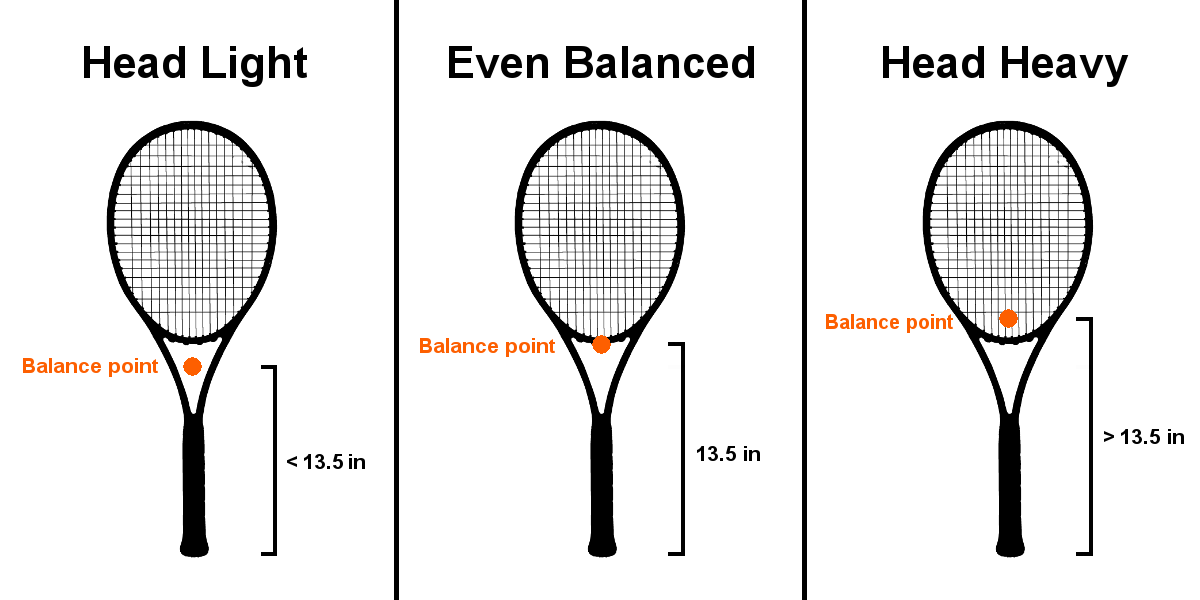
Tennis players with a short swing style like to play with a head heavy racket. Because of the overweight in the head of the racket, you develop a large swing power and can create a high acceleration of the tennis ball.
On the other hand, the maneuverability of the racket suffers. The center of gravity in the area of the racket head makes it difficult to swing precisely. You therefore have less control over your swing.
Most experienced players prefer a racquet with a head light balance . This one has more weight in the grip area. This feature increases maneuverability of the racquet as the center of gravity is closer to the body.
On the one hand, this gives you very good control but on the other hand the acceleration is not as high as with a head heavy model. You have to be able to generate enough power yourself. So if you have a strong and powerful swing style, a head light racquet is the right choice for you.
An even balanced racquet will have almost the same weight in the grip and head. This all-around racquet is the middle way between a head heavy and a head light racquet. It offers you both medium speed and average shot control.
7. Grip Size
The grip size is the circumference of the racket handle. Usually, it is indicated in inch, in European countries also in cm or with numbers. In order to give you the best playing comfort, the grip must be adjusted to your own hand size. There are two ways to determine the correct grip size:
Measuring the Hand
All you need is the hand with which you play your forehand and a ruler. Keep your hand stretched out and position the ruler along the inside of your ring finger (see picture).
In the next step you measure the distance from the tip of your ring finger to the lower horizontal fold of your hand. You can then compare the measured distance with the correct grip size in the table below.
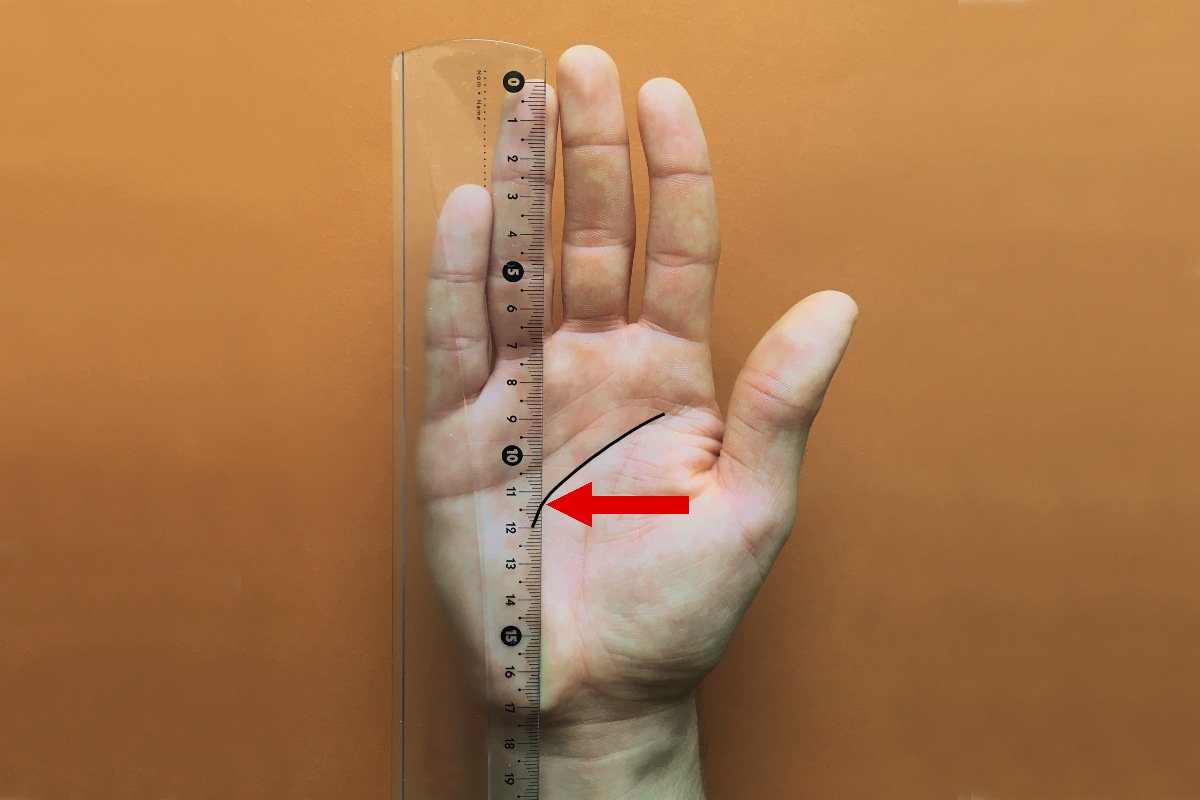
| US Grip Size | European Grip Size | Size in cm |
|---|---|---|
| 4 inch | L0 | 10,2 cm |
| 4 1/8 inch | L1 | 10,5 cm |
| 4 1/4 inch | L2 | 10,8 cm |
| 4 3/8 inch | L3 | 11,1 cm |
| 4 1/2 inch | L4 | 11,4 cm |
| 4 5/8 inch | L5 | 11,7 cm |
Tip: If your value now lies between two grip strengths, e.g. between 4 3/8 inch and 4 1/2 inch, we recommend that you always select the smaller of the two grip sizes. With overgrips or a new replacement grip you are able to increase the circumference of the grip and thus the grip size. Unfortunately, it is not possible to reduce the grip size.
Forehand Grip with Index Finger
If you want to check the grip strength of your tennis racket, you can use the following method. Take the grip in your hand and hold the racket as if you were playing a normal forehand.
Now take the index finger of your other hand and try to place it in the gap between the tip of your ring finger and the palm of your hand (see picture). If the grip size is right, your index finger will fit exactly into this gap.
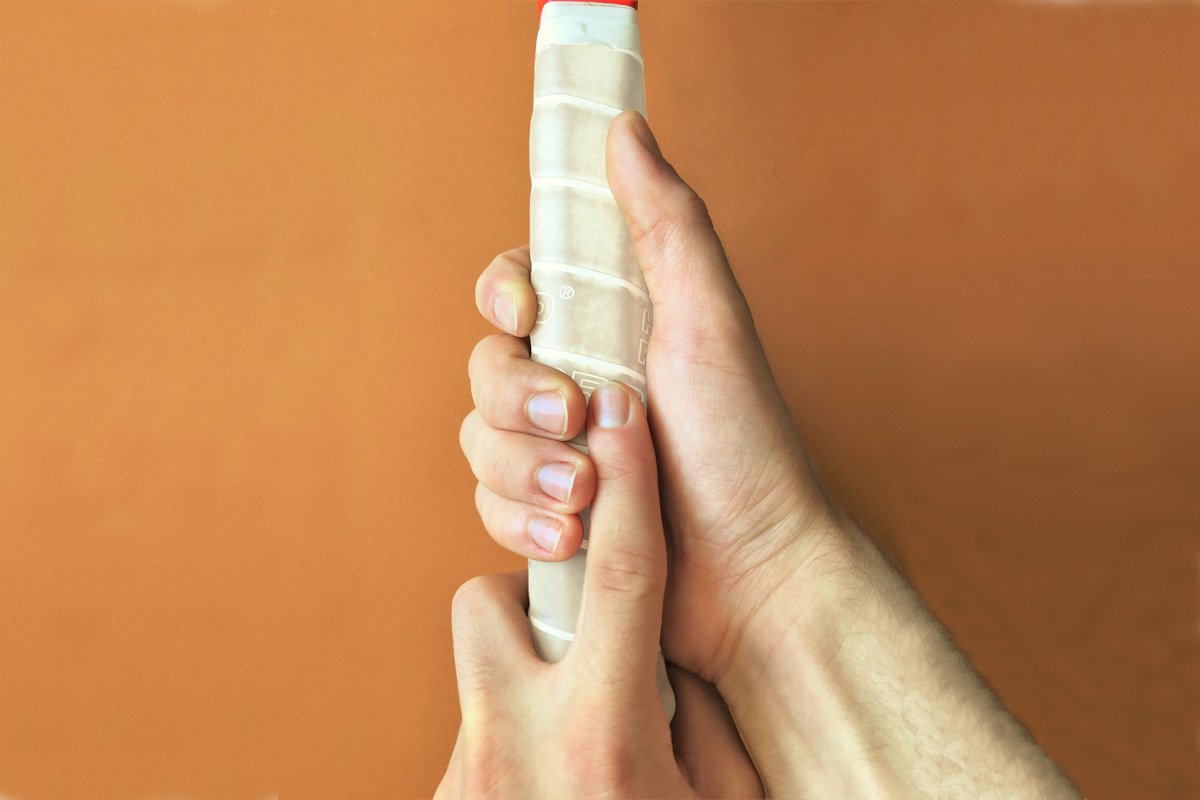
8. String Pattern
The string pattern expresses how many main and cross strings your tennis racket has. The number of main strings is always given first and followed by the number of cross strings.
For example, with a 16×19 string pattern, the racket has 16 main strings and 19 cross strings. The most common string patterns of tennis rackets are 16×19 or 18×20. Depending on the number of strings, we distinguish between an open and a closed string pattern.
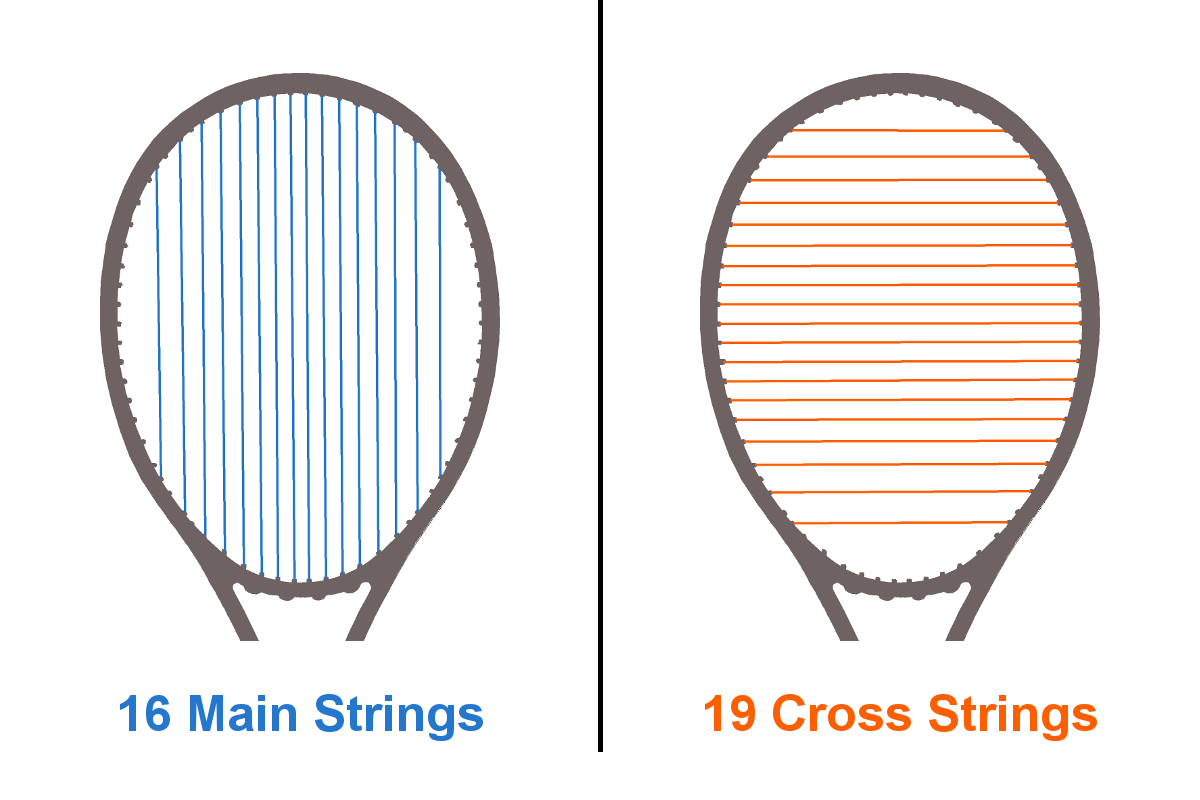
An open string pattern (e.g. 16×19) means that the racket has fewer mains and crosses. Accordingly, the distance between the strings is greater. With an open string pattern, you generally benefit from solid acceleration and high spin.
In this case, the strings give more slack, allowing the tennis ball to penetrate deeper into the string bed of the racket. This effect is also called the “trampoline effect”.
A disadvantage is that the strings are subjected to a lot of stress and therefore the durability is reduced. In addition, the control of the stroke is worse with this string pattern.
We advise you to choose an open string pattern if you are still a beginner or if you like to play with spin.
With a closed string pattern (e.g. 18×20) the tennis racket has more strings than with an open string pattern. The smaller spacing between the individual strings makes the string bed appear somewhat stiffer.
The ball can therefore no longer penetrate so deeply into the string bed when hitting the ball. With a closed string pattern, your racket has less acceleration and less spin potential, but you have more control over the shot.
In addition, the strings have a better durability, as they are less worn out. Most experienced players and professionals prefer a closed string pattern.
Tip: When buying a tennis racket, make sure whether it is delivered strung or unstrung. If the tennis racket is still unstrung, some manufacturers offer to string the racket with your desired string. If the manufacturer does not offer a stringing service, you can buy the racket and the string separately and then have the racket strung in a specialist shop.